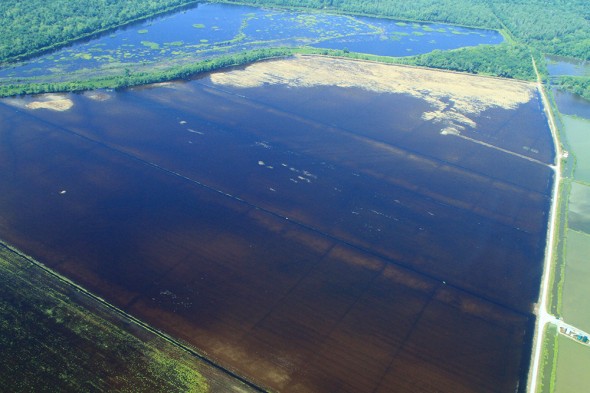Agriculture and Sewage Dead Zone: Taking on Nutrient Pollution in the Mississippi River Watershed
As the impact of agriculture on water quality intensifies around the globe, two lawsuits in the United States aim to reduce the size of the Gulf of Mexico’s ‘dead zone’ by setting limits on nutrient pollution in the Mississippi River Basin.

By Codi Yeager
Circle of Blue
Achieving quantifiable regulations for nutrient pollution in the Mississippi River Basin is the goal of two lawsuits filed last week by the Natural Resources Defense Council (NRDC). The NRDC, representing a group of concerned organizations, hopes such regulations will decrease the size of the hypoxic dead zone in the Gulf of Mexico.
The dead zone, which occurs annually from June through August, is an oxygen-depleted, or hypoxic, area that forms at the mouth of the Mississippi River when excessive levels nutrients like nitrogen and phosphorous generate massive algal blooms. When these blooms die and sink to the bottom of the Gulf, decomposition sucks up so much oxygen that other organisms cannot survive there. The largest hypoxic zone was recorded in 2002 and covered 22,000 square kilometers (8,481 square miles). While the size varies from year to year, data compiled since 1985 by the Louisiana Universities Marine Consortium show that the dead zone has been growing over time, due in large part to runoff from agricultural land and discharge from urban wastewater-treatment plants.
The NRDC feels that the U.S. Environmental Protection Agency (EPA) has not used its authority under the Clean Water Act to solve the problem, despite acknowledging the issue for more than two decades, according to Ann Alexander, a Senior Attorney with the NRDC who is working on the case.
“The EPA has recognized that nutrients are a problem and that we need to develop numeric regulations to control them,” Alexandar told Circle of Blue.
But the agency has not set numeric standards regulating the amount of nitrates and phosphates in the water, instead leaving it up to the states to implement narrative standards that describe the quality of water needed for a body of water to be used for a designated purpose, such as recreation. The states, for the most part, have failed to adequately enforce these standards, which prompted the NRDC to file a petition in 2008 asking the EPA to step in, Alexander said. Last year, the agency denied the petition, and now the NRDC is challenging this response in one of their lawsuits.
“This response doesn’t address that the states aren’t doing anything; that, with a few exceptions, they have failed spectacularly,” Alexander said. “The law says that, when there is a problem [with implementation], the EPA needs to step in and do what needs to be done.”
The second lawsuit filed last week seeks a response to a separate petition, filed in 2007, regarding sewage treatment, which remains unanswered. The petition asked the EPA to reevaluate its regulations for secondary — or biological — sewage treatment, taking into account technological changes and new capabilities developed since 1985, which was the last time the regulations were updated, Alexander said.
She added that the biggest hurdle to improving water quality in the region is jump-starting government systems into action. “The states and the EPA are under substantial pressure not to do anything about the problem, but the law requires that they do.”
The Costs of Conservation
Agriculture in the country’s Midwestern bread-basket contributes significantly to water quality issues in the Mississippi River Basin and, subsequently, the Gulf of Mexico. Some estimates suggest that 43 percent of the nitrogen and 27 percent of the phosphorous flowing to the Gulf originate in the Upper Mississippi River Basin (UMRB), an area encompassing parts of Minnesota, Wisconsin, Illinois, Iowa, Indiana, and Missouri. Agriculture occupies 67 percent of this area, and runoff packs a lot of nutrients into the water, though sewage from cities like Chicago also plays a major role.
“The water quality in this region is pretty bad. There is a lot of soil erosion, lots of nutrients in the water,” Catherine Kling, a professor in Iowa State University’s Department of Economics, told Circle of Blue. In 2010, Kling and other researchers developed a model to assess the economic costs and tradeoffs of different conservation methods that would reduce nutrient pollution in the UMRB.
“There is no requirement for agriculture, no limits on fertilizers or requirements for conservation practices,” she said. “The hope is that they will voluntarily adopt conservations methods, but these are costly.”
The 2010 study found that reducing nitrogen and phosphorous pollution could cost between $US 370 million and $US 1.4 billion each year, depending on the methods used. The cost necessitates careful planning when implementing conservation measures, Kling said.
“Because it would be very expensive to put conservation measures in place everywhere, it is important to target places where they would be most effective.”
A Global Issue
As the world’s population grows — expected to reach nearly 9 billion by 2050 — increased agricultural production will continue to put pressure on water quality. Last week, a report by the Paris-based Organization for Economic Cooperation and Development (OECD) estimated that the environmental and social costs of water pollution from agriculture exceeds billions of dollars annually in its member countries, though it acknowledges that no comprehensive data on this issue exist. In Australia, for example, agricultural water pollution costs around $US 62 million each year.
Costs in countries that are rapidly expanding agricultural production, like India and China, are expected to increase.
Source: Louisiana Universities Marine Consortium ; OECD
A news correspondent for Circle of Blue based out of Hawaii. She writes The Stream, Circle of Blue’s daily digest of international water news trends. Her interests include food security, ecology and the Great Lakes.
Contact Codi Kozacek







When EPA implemented the Clean Water Act it used an essential test incorrectly and as consequence ignored 60% of the pollution in sewage. Among this waste ignored was (and still is) all the nitrogenous (urine and protein) waste, while another problem caused by this test is that we still do not know how sewage is treated and what the effluent waste loading is on receiving water bodies. In 1984 EPA acknowledged the problems caused by this test, but never corrected the test. In stead it allowed another test, whereby EPA officially ignored 60% of the waste in sewage, claiming that treatment of nitrogenous waste was not necessary and would be extremely expensive. All this in spite that EPA in one of their reports in 1978 already admitted that not only much better sewage treatment was available, but also could be built and operated an lower cost as conventional sewage treatment plants, which are based on a century old technology solely developed to prevent odor problems.
Admitting to this mistake apparently s too difficult and therefore easier to blame this ‘nutrient’ pollution to the runoffs from farms and cities. All the new programs however will again fail if this essential test is not corrected.